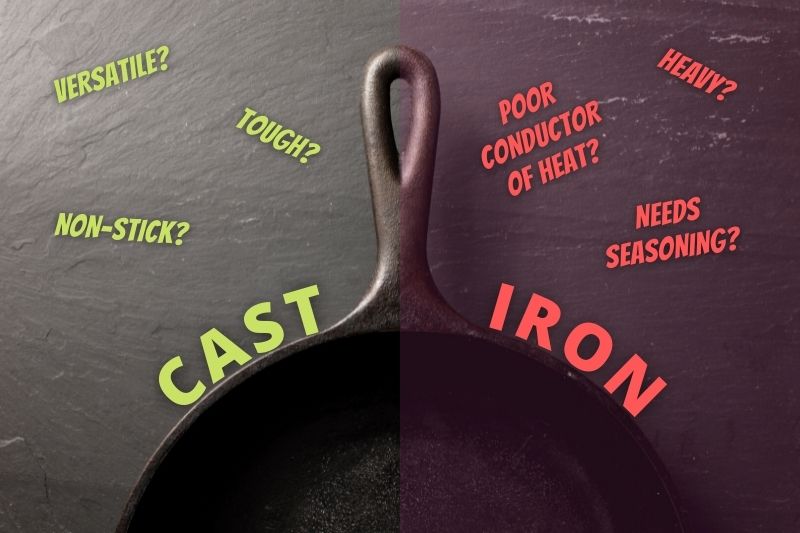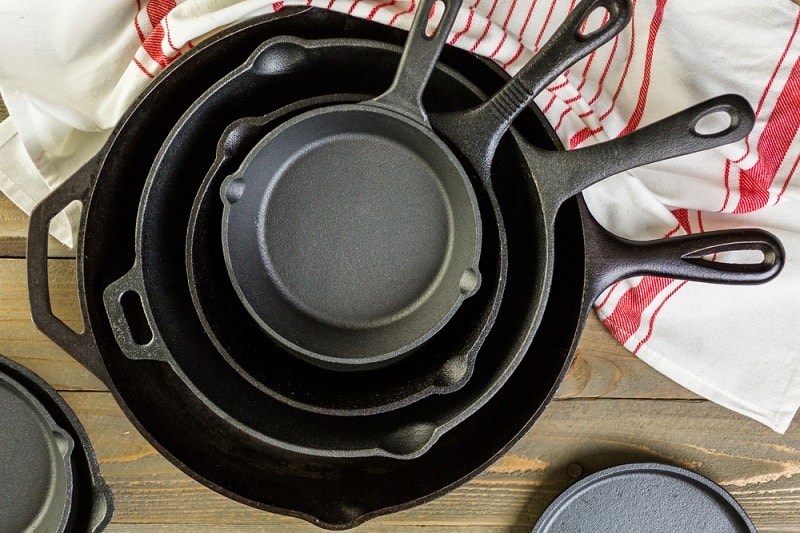Cast iron has been in our kitchens since the 16th century when casting techniques became widespread in Europe.
The earliest example of cast iron cookware comes from 220 AD in China. Interestingly, the nearly 2,000-year-old cast iron skillet looks like the cookware we still use today.
So, why has cast iron cookware been in our kitchens for so long? And why, when there are modern non-stick technologies that are superior to cast iron, do many of us still lean towards cast iron?
Well, here’s an overview of the advantages and disadvantages of cast iron cookware. Hopefully, it will shed some light on the reasons why this cookware is still so popular.
Advantages of Cast Iron Cookware
1. Versatile

Cast iron cookware is fantastically versatile, more so than almost any other type of cookware. You can use cast iron on BBQs and open fires.
You can also use it on every type of hob, including induction. It can also go in the oven. So, however you want to cook a meal, cast iron will always be there with you.
It isn’t just versatile in terms of which heat sources you can use it with—cast iron can be used to cook just about anything too. Most people use it for frying steaks to perfection; I know I certainly do. However, you can fry eggs, sauté veg, bake cookies, and loads more.
You can even make stews in cast iron cookware and transfer them straight to the oven. The versatility of cast iron really knows no bounds. You cook anything anywhere in cast iron.
2. Tough
Cast iron cookware is designed to last years. Most modern pots and pans are designed to last 3-10 years if you’re lucky. Cast iron cookware can be passed through generations of passionate chefs.
Granted, cast iron can be brittle in certain circumstances. This is why you shouldn’t rapidly cool it. Still, treat your cast iron right, and you’ll likely be passing it on to your kids so they can enjoy cooking with it for decades as well.
3. Makes tasty food easily
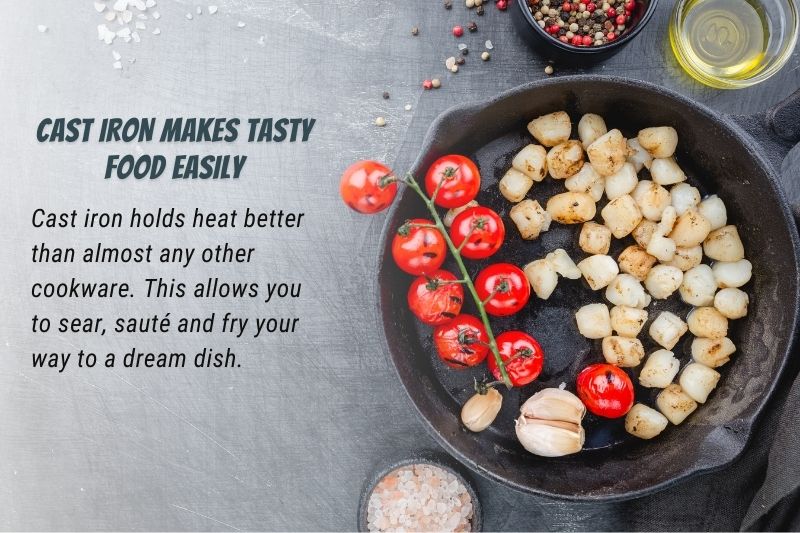
Cast iron cookware can get a bad rap for being complicated to maintain and season. However, the seasoning process is really simple; more on that in a bit. And once the seasoning is done, maintenance is a breeze.
After this, cooking with cast iron is so easy, yet it produces some of the tastiest meals ever. This is all thanks to the incredible heat retention of cast iron. It holds heat better than almost any other cookware. This allows you to sear, sauté and fry your way to a dream dish.
4. Natural non-stick properties
The seasoning of a cast iron pan provides it with a non-stick coating that will last years and years with little maintenance required. You simply need to top the seasoning up every so often.
However, one of the best things about cast iron cookware is that if the non-stick coating is ruined somehow, you can simply reapply it.
Once the non-stick coating on modern pans starts to flake off, you must buy another pan. With cast iron, though, if the seasoning is ruined, give the pan a good scrub, heat it up on the hob and add a thin layer of oil, wiping away any excess.
There you go, you’ve just reseasoned your pan, ready for a few more years of use.
Disadvantages of Cast Iron Cookware
1. Heavy
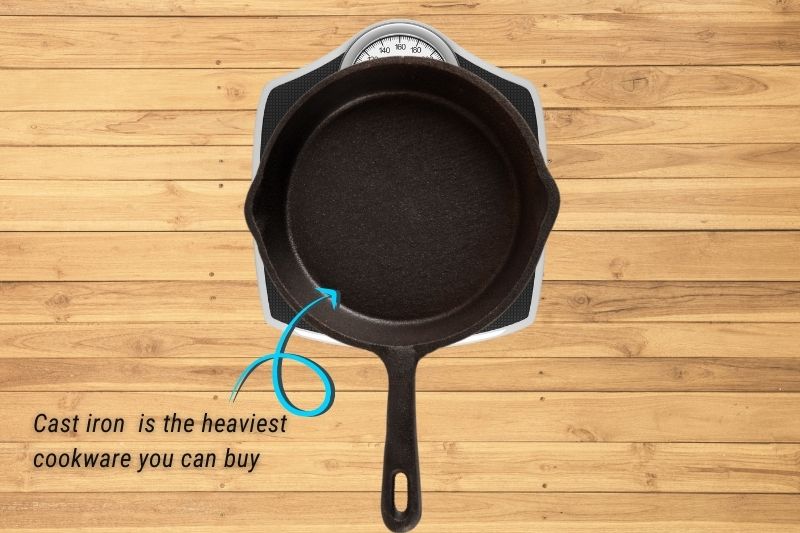
Cast iron cookware is hefty. It is the heaviest cookware you can buy. However, this heft does have a purpose.
Firstly, cast iron is brittle, so the thicker the pan, the tougher it will be. It also helps to retain as much heat as possible.
So, if you prefer lightweight pots and pans, cast iron might not be your thing. However, if you can handle the heft, you will love what this cookware does in the kitchen.
2. Must be seasoned
A lot of cast iron cookware available today comes pre-seasoned from the factory, but you still need to top up the seasoning every so often. If you don’t, food can start sticking to the pan.
While seasoning cast iron seems daunting, it is actually incredibly simple. Just heat the pan up and wipe a thin layer of oil over it every three months or so.
We’re including seasoning as a disadvantage simply because other cookware doesn’t require it.
3. Requires maintenance and careful cleaning
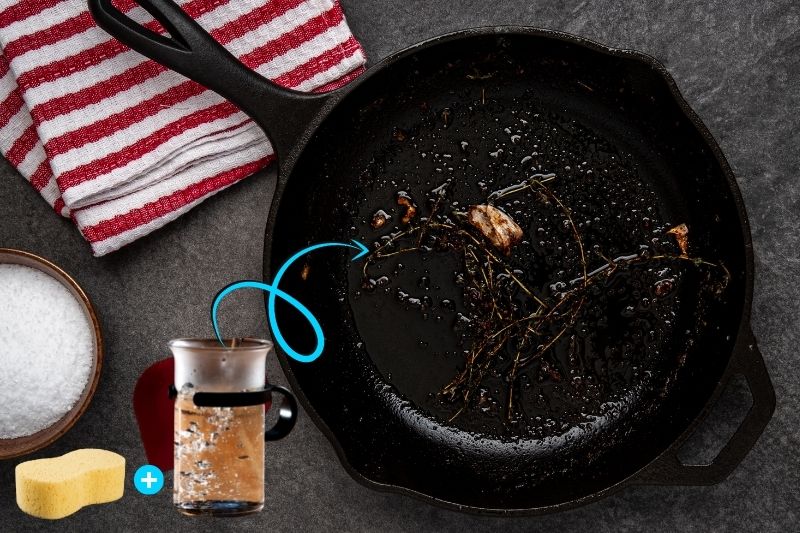
Now that you’ve seasoned your cast iron cookware, you can use it to cook amazing meals. However, there is some maintenance to take into account.
You can’t put cast iron cookware in the dishwasher as it will destroy the seasoning. You have to wash cast iron cookware by hand. A wipe with a soft sponge and some hot water is likely all that’s needed to maintain your cast iron, though.
Cast iron also rusts, so you need to keep on top of your seasoning. If you see rust spots on your pot or pan, you can remove them with a rough sponge and then redo the seasoning.
The maintenance of cast iron cookware seems more daunting and more involved than it actually is. As long as you hand wash it after use and top the seasoning up every few months, you won’t run into any trouble.
The only reason maintenance is a disadvantage is because other types of cookware require much less of it.
4. Poor conductor of heat
Finally, cast iron is a poor conductor of heat. It has fantastic heat retention properties, but it takes a while to heat up.
If you like to cook meals quickly, cast iron can be a bit frustrating to use. However, if you have some time to wait, cast iron locks in heat very well once it has heated up.
If you want to give cast-iron cookware a try in your kitchen, and frankly, you should, it’s the most enjoyable piece of cookware to use; check out Chef’s Pick further. We have the best cast iron cookware available in the UK right here including the best cast iron skillets.

Scott is a writer and a passionate home chef. His passion for cooking began when he was 10 years old. Scott has been writing professionally for over five years now and loves to combine his passion for cooking with his day job.

